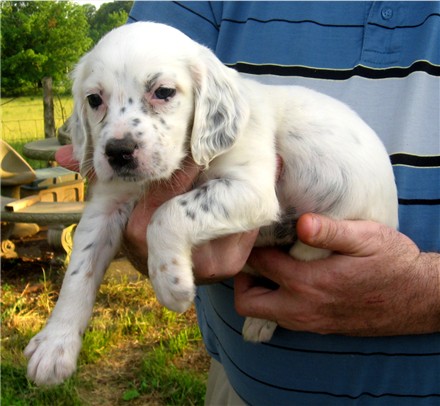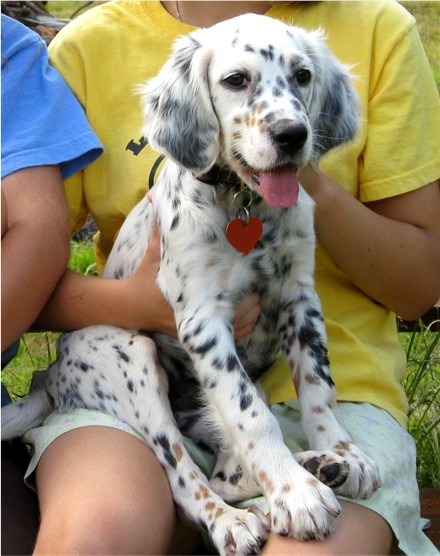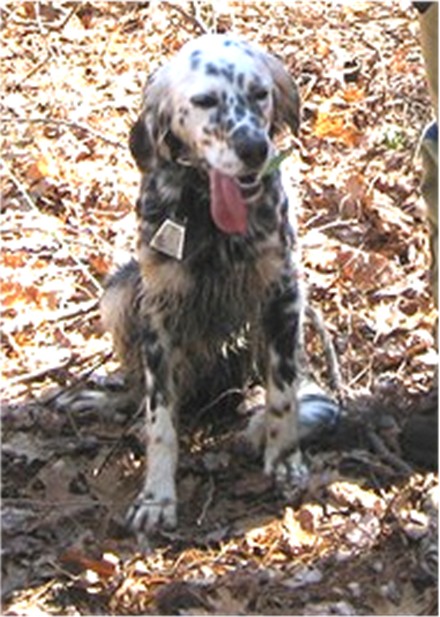in the International Progressive Dog Breeders Alliance registry, the Llewellin Setter does not have a Breed Standard like in other registries. The reason for this is that the IPDBA Llewellin Setter Breed Charter, did not want them to be eligible for dog shows. It was their concern that if they were bred for show, they would lose their amazing abilities in the field and as companion dogs. The Llewellin Setter is a foot hunting Setter and all breeding is to concentrate on their natural abilities in hunting and willingness to please. Personally, I don't agree totally with that statement, as I believe how a dog acts around the home and kennel, it's temperament, etc. is very important and should not be over looked in any top breeding program.That being said, everyone likes a good looking dog and everyone wants their dogs to look like their respective breed. When it comes to a dogs looks, regardless of their breed, there are different opinions on what they should look like. In most breeds the few members of an elected breed committee draw up a Breed Standard and the membership vote and the majority wins. The problem with this system is that only a few are involved in the writing of the Breed Standard it self and are usually people who show their dogs. Instead of making an ideal standard of what an ideal goal should look like, it is most likely written to look like the dogs they have today in the breed so they can win titles, resulting in dogs that fall far short from an ideal.
Unfortunately, people who show are usually not the same people who hunt. Heck, even those hunt for pleasure seldom enter field trails and is why Field Trial type dogs are usually not suited for the average foot hunter and visa-versa. It is very tempting to purchase a pup from Field Champion pedigrees, but that is the worst thing a foot hunter could do.
So as long as their are shows, Field Trails and pleasure hunters, their will always be THREE types of dogs developed. This is why I personally like "Gun Dog Certification", because the inspection just looks for four natural qualities, #1 Hunt (search for birds) #2 Point (solid on bird scent), #3 Retrieve (shot bird to hand), and #4 Backing (honor another pointing dog). No emphases on how long it takes, how wide the dog hunts, how the dog looks, the breed of the dog, or who owns the dog, just the four fundamentals of a good pleasure bird hunting dog.
OK, let us get back to the description or looks of the Llewellin Setter. Fortunately, good hunting dogs usually mean good genetic form, or what makes a good physical hunting dog, like straight legs, tight toes, light footed, big chested, straight back, big muzzle, medium coats, strong hind quarters, etc..
The Llewellin Setter puppy is predominantly white at birth. As the cute fuzzy ‘puppy coat’ of a Llewellin Setter pup sheds they will soon develop small colored spots (called ticking which is indicated as Ticked, abbreviated Tkd). The ticking will be the same color as the major patches, such as Black, Orange/Tan, or Chestnut (liver) all over their body. The ticking color will sometimes vary a lot on different parts of the body and is always more distinct and sometimes appears darker on the extremities of the Llewellin Setter.
You will notice that the ticking on the litter diagrams is indicated at varying degrees of intensity. The mature amount of ticking on the body of a Llewellin cannot be determined with certainty at birth. At the time the Llewellin Setter pup is 5 to 6 weeks old the ticking begins to show clearly on the belly, legs, nose and ears. When a Llewellin pup is between 3 & 6 months old, it will begin to reach its full coloration. The degree of ticking indicated on the charts is an educated guess based on the amount of ticking on the skin of the belly of the pup and the parents.
[1] BASIC COLORATION OF THE LLEWELLIN SETTER
Dominant color is always listed first in the color classifications with the lesser color listed second and so on.
White, Black, & Ticked -- White, Orange/Tan, & Ticked -- White, Chestnut, & Ticked
Rarely the coloration can be listed as Black, White, & Ticked – Orange/Tan, White, & Ticked – Chestnut, White, & Ticked!
Again all large spots will show up on the pup at the time of birth.
[2] White, Black, & Ticked: The most common color with solid Black Markings and Black ticking,
no tan markings or ticking..
Example: Differences between a Tri-Color and White, Black, & Ticked with similar markings.
[3] TRI-COLORATION: Basically, they have the same pattern as their cousin the Gordon Setter with Orange/Tan spot over each eye and Orange/Tan on muzzle, cheeks, feet, under ears, belly and their under parts. See examples below....
Tri-Coloration
Note: how the Tan/Orange appears in the same location on a
Tri-Color Setter as it does on the Gordon Setter.
Examples of Gordon Setters
Examples of Tri-Coloration
Gordon Setter
Tri-Color
Gordon Setter
Tri-Color
Gordon Setter
Tri-Color
Gordon Setter
Tri-Color
TRI-COLOR LLEWELLIN SETTERSAgain dominant color is always listed first in the color classifications with the lesser color listed second; while the TRI-COLORS have a third color.
TRI-COLORED Llewellins are not common in some lines, but are very common in the Dashing Bondhu line!
TRI-COLOR term is used on pups that are a combination of White, Black, TAN (Orange) and Ticked.
Rarely a Tri-Color will be White, Chestnut, Tan (Orange) and Ticked and are listed as TRI-CHESTNUT.
Quad-Color: Has not been genetically proven to be a possible color combination as Tan and Orange are the same gene and a dog cannot have Chestnut and Black because the dilute gene that makes the Black appear as a Chestnut in color would have to be present changing all the Black on the dog to Chestnut.
The same goes with Lemon as to get Lemon, you must have the Orange/Tan gene and a dilute gene present that makes it appear Lemon. You cannot have Orange and Lemon on the same dog. You can have different shades of the same color, but lighter color on the ears or different parts of the body does not constitute a different color.
It is virtually genetically impossible to produce a Setter with 4 or 5 different colors. Shads of the same color are common, but not different genetically.
Bottom line, if you think you see more than 3 colors on your Llewellin Setter, it may not be genetically possible and be registered as a Tri-Color, but you still have a beautiful Setter that appears to have more than three colors to the eye.
Until proven genetically possible, IPDBA will not recognize more than three colors on a Llewellin Setter. They will be registered as Tri-color, Tri-Belton, Tri-Chestnut, or as Tri-Chestnut Belton.
The Red Irish Setters are perfect examples of how the same color can appear differently on different areas of a Setters body. This is the same effect seen on Tri and other Llewellin Setters that appear to have different colors like orange, tan, chestnut, blue, etc..
Note: Lighter shade of red on ears, chest, and feet.
Note: Lighter shade of red on ears chest, & under parts. Also note, darker body coloration, appearing to be Chestnut in color.
Note: Lighter shade of red on top of head, ears & chest.
Note: Lighter shade of red on ears, under parts and tail.
[3] BELTON LLEWELLIN SETTERS: A TRUE BELTON IS BORN SOLID WHITE. Many confuse the term Belton incorrectly with the term Ticking. So some English Setters have been called all Setters a Belton, even if they have body markings, but any Setter with markings is NOT a Belton.Some Llewellin Setter pups are born solid WHITE! As they mature they will NOT have major body patches of color, only ticking. These are recognized as a Belton.

True Tri-Belton pup at 3 wks
(born all white and still all white)
Same Tri-Belton pup at 6 wks old
(has faint ticking on body, but showing ticking on belly, legs, ears, and muzzle)
Same Tri-Belton pup at 3 months old
(Tri-Belton is 3/4 ticked)
Same Tri-Belton pup at 12 months old
(Tri-Belton is fully ticked now)
Amount of Ticking will vary from pup to pup.
They will only end up marked with a number of small spots or ticking and are called BELTONS: Orange Belton, Chestnut Belton, or Blue Belton which are actually Black Beltons, but their ticking appears Blue because of the overlay of White hair over their ticking. This will also make an Orange Belton appear to have Tan Ticking and a Chestnut Belton sometimes appear as a Red-Belton if enough ticking is present.
Some Beltons will be Tri-BELTONS or TRI- Chestnut BELTONS!Tri-Beltons are the same as a Blue Belton but develop Orange/Tan ticking around the muzzle and on the paws, etc., like the Tri-color. This can vary so much from just one tick on each paw and muzzle, so that they are not seen until adults, to heavy ticking half the way up their legs making it very easy to tell they are Tri's at an early age. The amount and shading will vary, depending on the area of the body and length of hair.
TRI- Chestnut Beltons likewise develop Orange/Tan ticking around the muzzle and on the paws and the amount and shading will vary, depending on the area of the body and length of hair.
Just like with all Llewellin Setter colors, a Belton's ticking may be lightly, moderately or heavily ticked.
In the Llewellin Setter the Belton ticking is the same type of spotting as the spots of color on a Dalmatian, the difference is in the long coat of hair on the Llewellin body. Rarely this ticking does not tend to mingle with the surrounding white coat and in such case the distinct dots of Dalmatian type ticking is striking. In the Llewellin the eventual coloring description on these white Belton pups is impossible to determine until around 5 to 6 weeks of age.
The degree or amount of ticking of an individual Llewellin pup can only be estimated by the amount of ticking on the skin of the belly and the actual amount of ticking could take 6 months to fully show.
The mating of two Llewellin Setter dogs of like coloration is not an absolute in determining the coloring of their offspring.
The Orange/Tan gene coloration is present in most Llewellin Setters. It can be carried both as a dominant or as a recessive.
The presence of the Orange/Tan coloring possibility is what makes the range and variety of coloring possible within each litter of the Llewellin Setter.
Only 100% Pure Llewellin Setters are Registered with IPDBA
(International Progressive Dog Breeders Alliance)
IPDBA has not had ANY dogs with DNA problems, nor has registered a ANY dogs who have in other registries. IPDBA has permanently banned ANY and ALL questionable dogs and ALL their offspring from their registry. Many of these are still being bred in FDSB, NSTRA, UKC, and AKC.
The sex has nothing to do with the hunting ability or quality of bird dog they will make, especially with the Dashing Bondhu strain. Size may very between different bloodlines. The males are usually more handsome and average 5 to 10 pounds more than females and ultimately size may have a lot to do with personal choice. The choice of sex is just a matter of personal preference with the Dashing Bondhu bloodline.
Photos are used here for education only under the "Fair Use" and are copyright© protected by their owners.
Click on paw print below!
All documents, photographs and graphics are Copyright © 1996-2024 Mountain View Kennel. Background photo of Dashing Blaze Bondhu, pure Dashing Bondhu Llewellin Setter dedicated in her
loving memory.